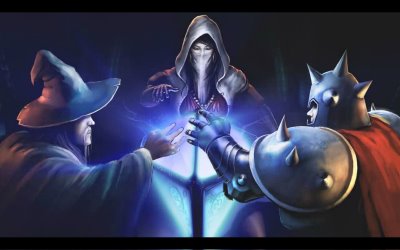Editor’s note: While I had a hard time getting past Trine’s $30 price tag, Davneet has found comfort in the feelings of nostalgia the game evokes. Maybe I need to play it some more and see if I can find my happy place. – Aaron
Nostalgia is a powerful emotion. It evokes deep-rooted and compelling feelings; it provides a sentimental yearning for a time in which experiences were more pleasurable and intense. Few modern games have the ability to induce nostalgia more so than Trine. Every aspect of Frozenbyte’s side-scroller, from gameplay to story to graphics, provides a longing for past experiences, whether they be videogames or otherwise.

Perhaps one of the more obvious nostalgic aspects is the gameplay itself. Despite full three-dimensional rendering of playable characters, non-playable characters, and environments, Trine is simply a two-dimensional side-scroller. It’s a return to a time when there were no camera-control and collision-detection issues. Because of that, the game is immediately accessible and intuitive.
Simplified combat compliments Trine’s presentation. Protagonists are not cluttered with an inordinate or a redundant number of attack abilities; nor do enemies have complex or multi-tiered behaviors. An enemy’s fighting abilities are straightforward and obvious upon first glance, as are the necessary actions to counter and defeat it.
Much like side-scrolling action-platformers of old, Trine’s gameplay places an emphasis on movement as opposed to combat. The bulk of the gameplay involves moving from point A to point B. This is made challenging by various obstacles and puzzles which require precise timing and thought to overcome.
Not all of Trine’s puzzles are simple. Many require precise timing and necessitate modification of the environment. Players have the ability to supplement the environment with boxes and platforms to traverse a level. This, along with the game’s use of realistic physics makes it rewarding to solve puzzles creatively, as opposed to simply requiring the push of a button to initiate hidden mechanics.
For the most part, each level builds upon this formula of straightforward combat and physics-based puzzles in a steady manner. Unfortunately, this progression is broken by the last level, which recalls the overly difficult and frustrating side-scrollers from the 8-bit era of videogames. Thankfully, it also provides the same sense of relief you’d get from those games when you’d overcome a particularly taxing obstacle.

Ultimately simplistic in design, the story follows the familiar archetype of "evil threatens land, heroes band together, heroes defeat evil, and everyone lives happily-ever-after." The game does not fight this overly used archetype, nor does it attempt to hide it beneath intricacies and details. Frozenbyte created Trine as a pseudo-frame story, with an independent and omniscient narrator reciting the three protagonists’ tales between levels. It harkens back to being tucked into bed at night and read to by a loving parent. At the least, it’s just as familiar and comfortable.
The game’s three protagonists each have a unique background and personality. First introduced is the thief, a cynical female whose main concerns revolve around extracting herself and any possible profit from the principal predicament. Introduced second is the wizard. He’s a student still learning the arcane arts, though he’s still somewhat knowledgeable of aspects related to the predominant threat. Last is the knight. The knight is a man noble in intention, overpowering in strength, and unburdened by high-level thought.
Each of the protagonists is well-created with the inclusions of both character strengths and weaknesses. They are all instantly recognizable and relatable, and their occasional banter serves to endear them even further. However, perhaps the most disappointing aspect of Trine is the absence of any sort of character development.
Despite strongly established starting characteristics, which include obvious foibles, none of the main characters evolve. Their starting traits are essentially the same at the conclusion of the game. Granted, the happily-ever-after ending sees them all in various satisfying and amusing situations that add to the game’s overall classic feel. It is, however, unfortunate that none of their well developed flaws are ever addressed, despite obvious opportunities to do so.

Trine is enhanced by stunning environments and art design. Levels range from forests to caverns to dungeons and fit the fairy tale them nicely. Colors are vibrant throughout with the inclusion of gorgeous detail such as giant fluorescent flowers and mushrooms, tiny glowing insects that swarm around lamps, and molten lava that heats and distorts the air. A pause in gameplay is required to appreciate all of the striking minutiae placed in each scene.
Though Trine is not as action-packed as many of today’s games, it is a joy to experience. It’s thoughtful, familiar, and ultimately comfortable rather than fast-paced or adrenaline-pumping. Comfort is not a metric typically used to evaluate videogames, but Trine achieves the maximum comfort level possible, and is a memorable experience as a result.


